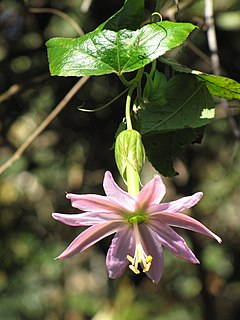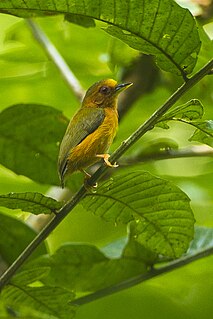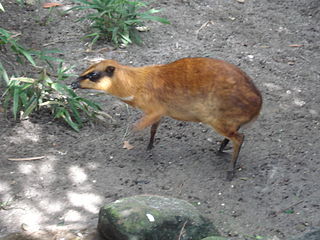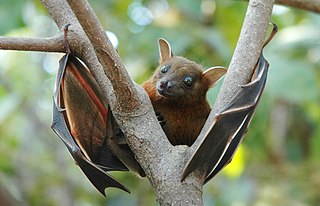
The proboscis monkey or long-nosed monkey is an arboreal Old World monkey with an unusually large nose, a reddish-brown skin color and a long tail. It is endemic to the southeast Asian island of Borneo and is found mostly in mangrove forests and on the coastal areas of the island.

The surilis are a group of Old World monkeys in the genus Presbytis. They live in the Thai-Malay Peninsula, on Sumatra, Borneo, Java and smaller nearby islands. Besides surili, the common names for the monkeys in the genus also sometimes use the terms "langur" or "leaf monkey."

Passiflora tarminiana is a species of passionfruit. The yellow fruits are edible and their resemblance to small, straight bananas has given it the name banana passionfruit in some countries. It is native to the uplands of tropical South America and is now cultivated in many countries. In Hawaii and New Zealand it is now considered an invasive species. It was given the name banana passionfruit in New Zealand, where passionfruit are also prevalent. In Hawaii, it is called banana poka. In its Latin American homeland, it is known as curuba, curuba de Castilla, or curuba sabanera blanca (Colombia); taxo, tacso, tagso, tauso (Ecuador); parcha, taxo (Venezuela), tumbo or curuba (Bolivia); tacso, tumbo, tumbo del norte, trompos, tintin or purpur (Peru).

Mangifera caesia is a species of flowering plant in the cashew family, Anacardiaceae. Common names include jack, white mango, binjai, wani, yaa-lam, bayuno/baluno/belunok and mangga wani. It belongs to the same genus as the mango and is widely cultivated in areas of Indonesia, Malaysia, Singapore, Brunei, Papua New Guinea and the Philippines.

The small-toothed palm civet, also known as the three-striped palm civet, is a palm civet native to dense forests of Southeast Asia, from the Assam district of India to Indochina and the Malay Peninsula and on Sumatra, Bangka, Java, Borneo, and numerous small nearby islands of Indonesia.

Phoenicophorium, the thief palm, is a monotypic genus of flowering plant in the family Arecaceae. The sole species is Phoenicophorium borsigianum.

The rufous piculet is a species of bird in the family Picidae. It is found in Brunei, Indonesia, Malaysia, Myanmar, and Thailand. Its natural habitats are subtropical or tropical moist lowland forests and subtropical or tropical moist montane forests. This species is one of the world's smallest woodpeckers and is the smallest woodpecker found outside the Americas. In this species the length can range from 8 to 10 cm and the average body mass is around 9.2 g (0.32 oz).

Prevost's squirrel or Asian tri-colored squirrel is a colourful species of rodent in the family Sciuridae. It is found in forests in the Thai-Malay Peninsula, Sumatra, Borneo and nearby smaller islands, with an introduced population in northern Sulawesi. Although the Prevost's squirrel is declining is some regions because of habitat loss and hunting, the species is not considered threatened since it generally remains common and widespread. It can live in somewhat disturbed habitats and often visits plantations or gardens. It mostly feeds on plant material, especially fruits, but also takes insects.

The greater mouse-deer, greater Malay chevrotain, or napu is a species of even-toed ungulate in the family Tragulidae found in Sumatra, Borneo, and smaller Malaysian and Indonesian islands, and in southern Myanmar, southern Thailand, and peninsular Malaysia. Its natural habitat is subtropical or tropical, moist, lowland forest.

The Malayan weasel or Malay weasel is a weasel species native to the Malay Peninsula and the islands of Sumatra and Borneo. It is listed as Least Concern on the IUCN Red List.
Cassine viburnifolia is a mangrove plant of tropical Asia in the staff vine family Celastraceae. The specific epithet viburnifolia refers to how the plant's leaves resemble those of the genus Viburnum.

The lesser short-nosed fruit bat is a species of megabat within the family Pteropodidae. It is a small bat that lives in South Asia and Southeast Asia. It weighs between 21 and 32 grams, and/or 70 to 127 mm. It occurs in many types of habitat, but most frequently in disturbed forest, including lower montane forest and tropical lowland rain forest, plus gardens, mangroves, and vegetation on beaches.

The island of Borneo is located on the Sunda Shelf, which is an extensive region in Southeast Asia of immense importance in terms of biodiversity, biogeography and phylogeography of fauna and flora that had attracted AR Wallace and biologists all over the world.

Oxera splendida is an evergreen vine in the family Lamiaceae which produces white, fragrant flowers and white, egg-shaped fruit. It naturally is occurs in the tropical rain forests of tropical Asia and Australia and is often sighted along rain forest margins such as roads. Some common names include October Glory, Glory Vine, Potato Vine and Fragrant Faradaya. Australian indigenous names include Garanggal used from Cairns to Yarrabah, Buku used in the Tully River area, Koie-yan used at Dunk Island and Djungeen used by the Girramay clan.

Rafflesia verrucosa was first identified and characterized during a small mammal survey of Mt. Kampalili in eastern Mindanao in 2010. R. verrucosa is the tenth species of Rafflesia found in the Philippines. Rafflesia species have rare and unusual flowers known for their large size and pungent smell. Some plant enthusiasts like Frits W. Went have gone to extreme measures to see these plants in bloom. Went detailed his search for Rafflesia saying,
"I had heard, when I was in Java many years ago, that Rafflesia were to be found on an offshore island named Nusah Kembangan. This was in 1929, when it was a penal colony for major criminals. My driver on this occasion was a convicted murderer, and my guide was serving time for cannibalism."
Durio kinabaluensis, also known as mountain durian and (locally) as durian tapuloh, is a forest tree in the mallow family.
Durio crassipes, also known as durian hutan, is a species of flowering plant in the mallow family that is endemic to Borneo.
Bouea oppositifolia, also known as plum mango, kundang, kundangan or remenia, is a species of flowering plant, a fruit tree in the mango family, that is native to Indochina and Southeast Asia.
Mangifera griffithii is a species of flowering plant, a fruit tree in the mango family, that is native to Southeast Asia.
Mangifera torquenda is a species of flowering plant, a fruit tree in the mango family, that is native to Southeast Asia.













